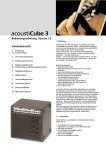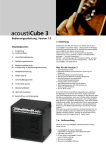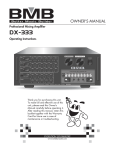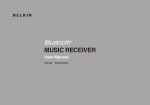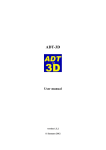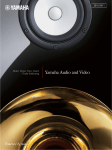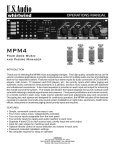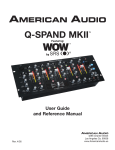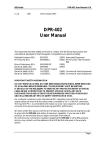Download AER combi-SUB 12 Operating instructions
Transcript
acoustiCube 3 Operating Instructions, version 1.0 1. Introduction Contents: 1. Intoduction 1.a. Contents of Delivery 2. Precautionary Measures 3. Operating Elements 4. Operating Basics 4.1 Further Operating Elements 5. Model Development 6. Effect-Charts, 1 and 2 7. Wiring Diagram 8. Technical Data 9. Signal Flow Diagram 10. AER Link-Function/Insert Point Welcome to AER. Thank you for purchasing the acoustiCube 3 – without a doubt the benchmark among amplifying systems for acoustic instruments (MIPA Award 2004 for Best Acoustic Amp). With version “3” we have made improvements to sound, dynamics, presence, and natural sound. Not to mention the features! In essence – we have combined all the suggestions of Cube enthusiasts with all our knowledge and without compromise. The result is the acoustiCube 3. Enjoy it! New for version 3 • • • • • • • • Two identical channels Bass-reflex cabinet separated from the electronics New two-way speaker system 44V dynamic reserve in pre-amp EQ range Separately adjustable and stabilised power source Pre-amp matrix: three pre-amps, two phantom power, combi-modus 32bit digital processor with USB-interface for parameter adjustment manipulation Aux in, mute, insert It is not easy to write a manual. For those of you with some knowledge of the technical matters addressed, much of what is mentioned may be obvious. Nevertheless, we recommend you take the time to read through the manual. That can help us to identify and correct mistakes and ambiguities. The acoustiCube 3 is a very complex amplifier – yet simple in its basic operation. This manual will be constantly updated. Please be so kind as to contact us via email [email protected] so that we can provide you with updates for as long as downloads from the website are not available. Thank you! 1.a Contents of Delivery Your acoustiCube 3 is complete if you find the following: acoustiCube 3 with bag, power cable, footswitch Acousticube IIa and 8-pole Din-footswitch cable • USB-cable type A/B 3m • CD with setup, acoustiCube 3 control, reset to factory settings • Manual acoustiCube 3 • Manual acoustiCube 3 software acoustiCube 3 -2- C 2. Precautionary Measures When using your acoustiCube 3, always take basic safety precautions to reduce the risk of injury by fire or electric shock to a minimum. Read all the directions in these operating instructions and make sure that you understand them. Pay attention to all warnings, instructions and supplementary text written on the acoustiCube 3. Always use a grounded mains connection with the appropriate voltage supply. If you doubt whether the connection is grounded, have a qualified expert check it. Please replace blown fuses only with those of the same type and rating. Do not repair them! When using your acoustiCube 3 always take basic safety precautions to reduce to a minimum the risk of injury by fire or electric shock. Always operate your acoustiCube 3 in a safe place where no one can trip over the cables to avoid accidents or damages. Do not operate your acoustiCube 3 near devices with strong electromagnetic fields such as large mains transformers, generators, neon lights etc. Do not lay the signal cable parallel to power lines. Ensure that your acoustiCube 3 is switched off before plugging the power cable into the mains. Before cleaning your acoustiCube 3, unplug it from the mains supply. Use a damp cleaning cloth. Do not use cleaning agents, and be careful that no liquid finds its way into the amp. There are no parts within your acoustiCube 3 that can be serviced by the user. Refer repairs and servicing to an agent authorised by AER. Any unauthorised repair or servicing will invalidate the two-year warranty! Should 48/9V phantom power be needed, first establish the proper cable connection (balanced cable or XLR plug or 6.3 mm stereo plug) and then switch on the amplifier. Otherwise the operating voltage will cause a short-circuit and endanger the functioning of your amplifier. C acoustiCube 3 -3- 3. Operating Elements Channel 2 same as channel 1 Front side, module (from left to right): input 2 clip piezo 9V 48 V mute line mic e/p clip channel 1 piezo 9V 48 V mute line mic e/p channel 2 program mode input 1 gain pad colour bass middle treble mute mode gain colour pad Input 2 input channel 2 Input 1 input channel 1 LED chain chain display for status and pre-amp choice overload indicator Mute channel mute indicator Piezo sources with piezo level, instruments with passive pick-up systems only Line sources with line-level, instruments with active pre-amps and/or magneticpickups 9V phantom supply for line function is switched on when mode switch is pressed in line modus for three seconds mic sources with mic-level, balanced and unbalanced 48V phantom supply 48V for mic function is switched on when mode switch is pressed in mic modus for three seconds E/P Electret-microphone/Piezo pick-up tip switch for input mode section pad switch to adjust input sensitivity gain input level control colour switch to activate mid-range contour filter mute mute control switch Bass tone control for bass middle tone control for mid-range treble tone control for treble program continuous program-selector encoder with memory-function, internal effect middle treble 2. 1 acoustiCube 3 pre master master return channel pan mute Clip mode bass power channel pan effect panorama control left: channel 1, mid: channel 1+2, right: channel 2 return effect return control, adds internal effect power mains indicator pre master level control for L-out, R-out and record ch1/ch 2 out master level control for the overal C -4- acoustiCube 3 Rear Module (from left to right) tuner sub L-out record ch1/ch2 presence made in germany send DI mic input effect 2 notch pan ser/par USB s p phones line R-out master insert aux in aux level DI level di-pre post effect 1=gnd 2=pos 3=neg master ctrl. return return Caution: Risk of electric shock. Do not open. tuner tuner output without tone control and effects phones stereo-headphone output including effects and aux-in signal. Use stereo plugs only! sub 6.3 mm jack as an output to drive an active sub-bass, AER SUB 12/400A line output for active loudspeaker box including tone control and effect, dependent on the master-control send output with EQ for external effect unit L-out line-out, adjustable via pre-master with tone control, effect, stereo reproduction of external effect and aux-in pan effect channel control for external effect (left: channel 1, middle: channel 1 + 2, right: channel 2), internal effect R-out line-out, adjustable via pre master with tone control, effect, stereo reproduction of external effect and aux-in return stereo jack for external effect unit or other signal-source ser/par switch for serial or parallel effect mode mic input balanced and unbalanced, parallel with front panel input 2 record ch1/ch2 stereo jack, tip: channel 1 and ring: channel 2, including tone control, without effect, pre-master master insert effect loop: input->return = ring / output -> send = tip, for serial effect looping or connection of AER amps via link-function (chapter10) aux in cinch-input L/R for e.g. CD player aux-return aux-return-control, mixes the aux-in signal to the overall signal presence presence-control, treble attenuation from 4kHz di-level DI-level-control, controls the level of the DI-signal di pre/post DI-signal pre or post effect di balanced XLR-output, pre-master, no tone control notch notch-filter, center-frequency 120Hz, for attenuation of feedback or instrument interference USB USB-port, connection of the AER DSPs with your computer for changing the effect parameters master ctrl. Multipin-DIN-jack for connecting the AER footswitch effect 2 (external effect) -5- acoustiCube 3 Back Panel (left to right) power power jack with fuse holder voltage selector voltage selector switch 115/230V ground lift ground lift switch which disconnects signal ground from protective conductor speaker out socket for passive bass box, e.g. AER SUB 12/250P Model:AcoustiCube 3 S/N: 040000097 230/115 V Fuse 3.15 A 0 4 0 0 0 0 0 9 7 6 C C acoustiCube 3 -6- 4. Operating Basics zed. Then reduce the gain in order to create some headroom (dynamic reserve) and determine the appropriate volume with master control. Starting up Ensure that the mains voltage at your location corresponds with what is permitted for operating your acoustiCube 3. You will find the necessary information on the rear sticker under "voltage” (AC-voltage). Before starting the amp, Model:AcoustiCube 3 S/N: 040000097 both master- and return-control should 230/115 V Fuse 3.15 A be on zero position (as far as it will go 4 0 0 0 0 0 9 7 6 0 left) and all other control buttons should be in mid position. Then make all necessary cable connections (mains, instrument, microphone, or link). Now you can switch on your acoustiCube 3 with the power switch at the rear of the amp. The green power lamp indicates that the amp is ready for operation. Choosing the best adjustment Decide which input stage at your amp is the best for your purpose: piezo line 9V mic 48V E/P for passive pickup systems only sources with line-level, instruments with active pre-amps and magnetic pickups phantom-power for line sources (max. power check technical data) balanced microphone input. Rear XLR-input mic input is parallel to input 2 phantom voltage supply for condenser microphone. for simultaneous operation of a passive piezo pickup and an electret microphone using a 3-pole instrument cable with stereo 6.3 mm plug. Assignment: tip=piezo, ring=mic. sleeve=ground Use the mode button to choose the appropriate input stage. In order to activate phantom power/voltage, press the button in line or mic modus for three seconds and the appropriate phantom power/voltage will be switched on. Level Control Please check as follows: Preconditions: Pad switch not in use, mute switch not in use; preamp of the instrument (if present): EQ mid position, volume open ca. 1/2 to 3/4. Now set the pre master and master control at the acoustiCube 3 in the zero position and increase the gain until the clip indicator shortly flickers while playing powerfully. If the gain adjusts itself ca.”9-11 o’clock”, you can be sure that the source, e.g. your instrument + pickup a) can completely level the Cube’s input stage and that b) the overall background noise level (hiss, drone) is minimi- The clip control generally indicates that the input signal is too strong. In fact, changing the active tone control affects the clip control. Short flickering is not dangerous. Still you should ensure that it stays that way. To be on the safe side, gain or volume of the source (instrument, microphone) should be slightly reduced to guarantee perfect and distortion-free reproduction. If necessary you can mute the amp’s channel with the mute control. Mute can be operated via footswitch, but the effect will be different (amp: ”hardwire”, footswitch: -40dB attenuation). Advice / Problems: Full drive can be achieved at a very low gain level. If the input signal is too strong it can be reduced with the pad-switch: if you do not succeed in making the input stage clip by turning on full gain and full volume on the instrument, the source’s signal is too weak. The audible result is not up to the performing standard of the acoustiCube. The background noise is too loud and the chance for feedback increase. Background Noise Analysis: Leave the adjustments as they are and turn the gain at the acoustiCube to the zero position. The only noise you will hear now is that of the acoustiCube. Open the gain until the prior position is reached, and then analyse how the background noise level changes. Tone Control: The acoustiCube’s three band tone controls are active and constructed to fulfil the specific requirements of both acoustic instruments and other sources. The colour switches activate a mid-cut-treble-boost-filter that especially suits finger picking. AER DSP 4 Digital Effect – internal effect The acoustiCube 3 has a built-in (internal) digital 32bit AER-effect processor. With the effect–programme–endless-encoder you can choose between 100 (0-99) effect programmes (factory settings: chapter 6). The number of the chosen effect can be seen in the two-digit display. The direction in which you turn the control does not matter. You can connect your acoustiCube with a computer via USB-cable, change the effect program parameters that suit your requirements, make combinations and store them under a new name. (See software handbook). Two of the 100 effects can be stored and recalled via the AER footswitch. You can select an effect and by pressing the programme-encoder on your acoustiCube this effect is stored. In the display you will see one dot, right next to the first digit. The first footswitch–memory–space is active. Selecting the second effect, the same procedure is followed. Now the display shows two dots. The second footswitch–memory–space is active. The footswitch button "memory” allows switching between the two footswitch-memory-spaces. acoustiCube 3 The dots in the display correspond to the indicators on the footswitch. The channel-pan control determines the effect’s spreading between the two channels. Please use the following control positions: As far as it will turn left: internal effect on channel 1, not on channel 2 Middle: internal effect on channel 1+2 As far as it will turn right: internal effect on channel 2, not on channel 1 C -7- 2. 1 acoustiCube 3 acoustiCube 3 display With the return level you determine the effect level of the internal effect. If the effect is not necessary, set the return level to the zero position (as far left as it will turn). program channel pan return acoustiCube 3 effect section Memory 1 2 Acousticube footswitch C -8- acoustiCube 3 4.1 Further Operating Elements Connections to module, rear (left to right, top to bottom) tuner sub L-out record ch1/ch2 presence made in germany send DI mic input effect 2 notch pan ser/par USB s p phones line R-out master insert aux in aux level DI level di-pre post effect At the tuner output, a line level is provided. You can connect a tuner parallel to your instrument without having to reconnect the instrument or connect the tuner into the signal path. At the phones output a stereo headphone-amp with max. 2 x 100 mW / 32 Ohms provides you with monitoring possibilities. Here the direct signal of channel 1 and channel 2 are mono, but the effect parts are stereo. The master control serves as volume control. The power amplifier and the loudspeaker are not in operation. The sub output is for the connection with the active auxiliary AER bass-box SUB12/400A. A special filter system relieves the loudspeaker system of the acoustiCube 3. At line out the total output signal is located. Here you can connect the active stereo extension AER CX8 and adjust the final volume parallel with the master level. L–out in connection with the R–out output as pre master total outputs can be used a) as parallel monitor paths or b) for direct connection with an AER PA –system such as AS281 or AS Q8 in combination with Sub 550D or CX8 in combination with SUB12/400 (pre master function see above). Record ch 1/ ch 2 bears the unmixed signals of channel 1 + 2, post EQ, without effect and pre master. Here you have access to the unmixed channel signals, e.g. for recording purposes. master insert The insert effect loop is input and output on a stereo jack for serial looping of effects with tip = send = output and ring = return = input. You can also use it for: 1. one additional line out 2. the link between two or more AER amps with insert function (AG8, acoustiCube or Compact Classic or Domino) 1=gnd 2=pos 3=neg master ctrl. return return Caution: Risk of electric shock. Do not open. For each function you will need the appropriate cable connectors. Example: As line output: stereo jack, tip + ring = hot, sleeve = mass -> on mono jack. For special AER link function, see the graphics in chapter 10. The link function enables all the signals of the amplifiers connected to be monitored on each amplifier even with different effect settings. The only restriction is that the levels are interdependent. But in connection with an active speaker system (pre master function, see above) you have a complete PA–system which can be easily handled from the stage. At the aux in inputs left/ right you can connect a CD/ MD playback signal and mix it to the overall signal with the aux level control. The signal is connected to phones as well as to L- and R –out. With the presence control you can influence the tone colour of the acoustiCube 3 by damping the whole treble range above 4 kHz. Thus you have the possibillity of adjusting your acoustiCube 3 easily for use with the different instruments (e.g. violin, classical and steelstring guitar, harmonica, etc.). As a factory setting, maximum treble reproduction and transparency were adjusted. The electronic balanced XLR-output di is for the connection with a mixing desk. Its output signal is the total output signal, post-EQ. The di-pre post effect switch allows switching the effects to the di signal. With the di level -control the output level can be adjusted to the mixing desk. With the usb connection you can connect the acoustiCube 3 with your PC to change the effect parameters and design your own effects. Please use the supplied USB A/B cable. For instructions please read the handbook Manual acoustiCube 3 Software.The master control socket is a DIN–multipin–socket. Here you can connect the Acousticube footswitch with the supplied DIN–cable. C acoustiCube 3 -9- That allows you to: Switch between the two stored effects (memory 1, 2) Switch on/ off the effect loops 1 + 2 Effect 1 (internal) on/ off: brief tapping Effect 2 (external) on/ off: longer tapping Please note: The signal path is interrupted in the serial mode. If no accessory unit is connected, the signal cannot find its way into the power amplifier, and you will hear nothing. This is not a malfunction but a misuse. Connect volume pedals or footswitches to sockets ctr ch 1 and ctr ch 2 to VCA level the volume of each channel or mute it (e.g. in tuner mode) without affecting the sound. When used in the serial mode, the pan control should be set as follows: As far as it will turn left: effect on channel 1, not on channel 2 middle: effect 2 on channel 1 and channel As far as it will turn right: effect 2 on channel 2, not on channel 1. When using a dual footwitch or a stereo volume pedal, a single stereo connection with ctrl ch1 is sufficient. effect 2 In addition, a further stereo effect unit, called effect 2, can be connected. The send socket needs to be connected to the input of the effect unit. That is it – have fun! The return socket is stereo, and accepts both output-channels of the effect unit. An "insert” -cable might be required (see "Wiring-Diagram”). The effect return and effect pan controls correspond to the controls at the front (effect 1). Please consider: If you use a mono accessory unit, you would also use a mono return-cable. The effect signal lies on the tip. The Acousticube internally uses the left effect portion of effect 1 that also lies on the tip. Thus your mono accessory unit is linked with the acoustiCube, but is only operative for the Acousticube. The signal is only available at line (line out) and r–out when a special stereocable is used. The mono-signal of the accessory unit should lie exclusively on the "ring” (middle ring) of the stereo jack (the effect only works on the right side, therefore not on the acoustiCube, only on the accessory box CX8). But if you connect "tip” and "ring” the mono-effect will spread to both sides (left and right), that is to the acoustiCube as well as to the stereo extension CX8. The ser/par-switch switches effect 2 from serial to parallel mode, depending on whether the original signal is supposed to pass through the effect completely (e.g. for EQ or compressor) or whether it is separated. AER GmbH und Co. KG. D – 45665 Recklinghausen Telephone: +49 (0)23 61–89 17 89 / -90 www.aer-amps.com Copyright: AER, Recklinghausen Telefax: +49 (0)2361 – 891791 AER assumes no liability for printing mistakes. Technical data is subject to alteration after printing. acoustiCube 3 5. Model Development From 1992 Acousticube Prototype From 1992 Acousticube I with ALESIS effect board (16 effects) 1994 Revised model with 48V phantom power from 12/1995 Change to Japan-FX-Board (ME-2) with 16 effects From 09/1996 AER Acousticube II with Japan-FX-Board (ME-2/ME-32) New features: 100 effect Three band tone controls Connection for an active subwoofer New power amplifier with output for an additional passive Box (SUB10) From 04/1998 AER Acousticube IIa with Japan-FX-Board (ME-32) New features: Balanced piezo input stage 100 effects, two with memory function and switchable via AER footswitch Mute/ master control function via pedalconnection on AER footswitch From 12/1998 New speaker system Beyma 8”BX/L New power amplifier with two-step limiter 2000 New outfit with WB-spatter lacquer From 04/2000 Revised effect chart: corrected assignment, selectable phaser and combined effects From 03/2002 AER Acousticube IIa with DSP3-FX-Board (AER processing) New features: Improvement of the effect section’s audio quality From 02/2003 Revised DSP3-firmware with combined effects and further improved audio quality From 07/2004 acoustiCube 3 -10- C C -11- acoustiCube 3 6. Effect-chart, 1 Reverb Room Room Room Room Room Room Room Room Room Room Hall Hall Hall Hall Hall Hall Hall Hall Hall Hall Hall Hall Hall Hall Church Church Church Church Church Church Church Church Church Church Church Church Church Church Church Church Church Cathedral Cathedral Cathedral Cathedral Cathedral Cathedral Pgr. No. Grp. No. description size / time 0 1 2 3 4 5 6 7 8 1 2 3 4 5 6 7 8 9 Dark small mid Soft small mid 9 10 11 12 13 14 15 16 17 18 19 20 21 1 2 3 4 5 6 7 8 9 10 11 12 13 Dark small mid Soft small mid Vocal short mid 22 23 24 25 26 27 28 29 30 31 32 33 34 35 36 1 2 3 4 5 6 7 8 9 10 11 12 13 14 15 37 38 39 40 41 42 1 2 3 4 5 6 large large Bright small mid large large large Bright Dark Soft long very long small mid large small mid small mid large Wood Warm Marble small mid large xlarge large xlarge small mid large xlarge Dark Warm Marble Dark Warm Marble long long long Ambience Glass Glass Glass Glass Church Church Church Warm Warm Warm Warm Dark Bright Bright Bright Bright Pgr. No. 43 44 45 46 47 48 49 50 51 52 53 54 55 56 57 58 Grp. No. description 1 2 3 4 1 2 3 1 2 3 4 1 1 1 2 3 size / time Room Hall Church XLarge small mid large small mid large xlarge xlarge xlarge small mid large C -12- acoustiCube 3 6. Effect-chart, 2 Special Acoustic Spaces & Outdoor Acoustic Spaces Corridor 59 1 Warm long Corridor 60 2 Dark long Corridor 61 3 Bright long Swimming Pool 62 4 Railway Station 63 5 Housing Estate 64 6 Ambience 65 7 Open Air Ambience 66 8 Piazza Ambience 67 9 Forest Ambience 68 10 Alpin Delay Soft reflection Pan Delay Pan Delay Pan Delay Pan Delay Vocal Vocal Vocal Vocal Ambient Refelctions Chorus Silky Warm Deep Mild Frozen Phasing Chorus Flanger Flanger Flanger Flanger Flanger Pgr. No. Grp. No. description size/time 69 70 71 72 73 74 75 76 77 78 1 2 3 4 5 6 7 8 9 10 Spacy Pan Delay Fast Pan Delay Pan Delay long xlong mid long slapback Pgr. No. Grp. No. description size/time 79 80 81 82 83 84 1 warm 2 3 bright 4 warm 5 6 fast fast slow Pgr. No. Grp. No. description size/time 85 86 87 88 1 fast 2 metallic fast 3 silky slow 4 spacy warm Combinations Pgr. No. Grp. No. description size/time Chorus Reverb Chorus Reverb Chorus Delay Chorus Delay Ambience Delay Ambience Delay Church Delay Groovy delay Stumbling reflections Soft reflections --> small church Delay --> Small church 89 90 91 92 93 94 95 96 97 1 2 3 4 5 6 7 8 9 98 99 10 11 bright bright -13- acoustiCube 3 C 7. Wiring Diagrams shield tip Typical „Insert-lead“ e.g. Effect II-Return, Master-Ctrl. ring shield sleeve 2 shield balanced Mic.-lead 2 shield unbalanced Mic.-lead shield Stereo-lead (balanced) e.g. Footswitch shield Mono-lead (unbalanced) e.g. Instrument 3 1 3 1 tip ring sleeve tip tip ring Special AER Insert Cable (look at chapter 10) ring tip C -14- acoustiCube 3 8. Technical Data Channel 1/2 piezo balanced/unbalanced sensitivity -26dBV, -11dBV with pad switch on noise < -82dBV line/ep unbalanced sensitivity -28dBV, -13dBV with pad switch on Switchable 9V phantom power on ring ( 2x100mA max) noise < -80dBV mic balanced sensitivity -38dBV noise < -80dBV Switchable 48V phantom power aux in effect 2 clip indicator L/R Cinch, unbalanced , 2x560mV >5 k Ω (impedance depending on "return" setting), return Jack, stereo, unbalanced, 2x 750 mV, >5 k Ω (impedance depending on "return" setting, left channel on internal speaker Headroom 6 dB OUTPUT tuner jack 1.3V, 100 Ω phones jack stereo, max. 1.7 V RMS, max. 2x 100 mW into 32 Ω For headphones only Do not connect to other devices Do not use mono plugs. master control 8-pin DIN socket , for Acousticube IIa footswitch, features: Ch. 1/2 volume control / mute (max –40dB gain reduction) effects memory 1/2 toggle effect 1/2 on/off EQ Channel 1 bass middle treble colour ±10 dB / 60 Hz ±6 dB / 600 Hz ±13 dB / 13 kHz –3 dB bei 100 Hz, +6 dB bei 10 kHz channel 2 bass middle treble presence filter ±12 dB / 100 Hz ±12 dB / 1 kHz ±12 dB / 10 kHz +0/–16 dB / 10 kHz notch filter -24 dB at 120 Hz BW-12 dB = 36 Hz analog signal processing AER low-distortion limiter, subsonic filter built-in effects AER 32-bit digital effects processor, 100 presets power amp 120 W sine-wave into 8 Ω, discrete bipolar transistor design limiter threshold 100 W speaker system 2-way speaker 8" (20 cm) low-midrang Hexacone driver, Neodym magnet 1" (25 mm) dome tweeter Neodym magnet mains power AC 115/230 V (switchable), 50–60 Hz, max. 200 W mains fuse slow 3.15 A, 5x20 mm cabinet 15 mm (0.59") birch plywood Finish waterbased acrylic, black spatter finish dimensions 330 x 330 x 265 mm (13"x13"x10.4") W x H x D weight 13.00 kg (28,66 lbs) di out XLR adjustable 60-240 mV, 100 Ω, balanced, pre/post effect sub bass jack max. 1.4V (post master), 100 Ω, with left channel of effects Activates 200 Hz active crossover for built-in speaker line out jack max. 1.4V (post master), 100 Ω, with right channel of effects L out, R out jack stereo effects, balanced adjustable 0–1.4 V, 100 Ω, Input and output voltages refer to 1 kHz sine-wave test signal. Input voltages refer to 100 Watts output into 8 Ω. record out channel 1/2 Jack, 1.2V, 100 Ω Piezo input sensitivities refer to 500 pF source capacitance and are given as open-loop source voltages. effect 2 send jack max. 1.2V depending on "pan" setting, 100 Ω speaker out subwoofer output jack, max. 120 W into 8 Ω Use only 8 Ω passive subwoofer with built-in 200 Hz crossover (AER Sub10/200P). Not suitable for full-range external speaker. Notes Output voltages refer to 50 mV at channel 1, line input. Impedance values for inputs and outputs are inner impedances (not source or load impedances - except for power. Noise measured at line output with filter 22-22.000Hz, Gain at max. position, pad off, EQ flat, all returns at min. position, input shorted, Master position refer to 100Watts output into 8 Ohm ( 1.2V at sub bass ) Specifications and appearance subject to change without notice. acoustiCube 3 9. Signal Flow Diagram, 1 -15- C acoustiCube 3 9.1. Signal Flow Diagram, 2 -16- C C -17- acoustiCube 3 10. Insert Point, AER Link-Function amp 1 amp 2 amp 3 tip ring line out tip insert ring tip tip return line out send insert ring L external effect ring tip R aux in In case of occupied „return” socket, due to the insert operating, you can still loop an external effect, using the effect „send” and the „aux in” sockets. tip return l-out r-out link link pre master amp 1 amp 2 amp 3

















